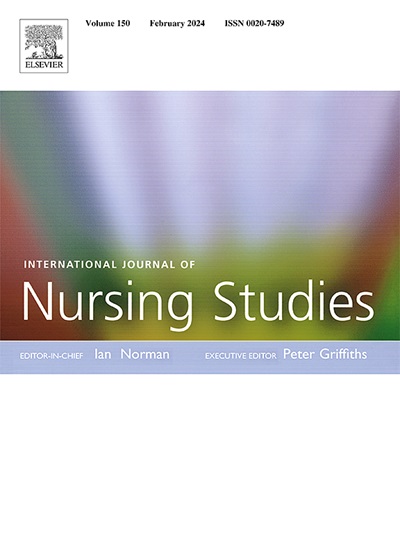Personal and work-related factors associated with nurse resilience: An updated systematic review using meta-analysis and narrative synthesis
IF 7.5
1区 医学
Q1 NURSING
引用次数: 0
Abstract
Background
Nursing shortages and increased workforce turnover have significantly increased nurses' workloads, thus increasing the risk of burnout and stress, particularly during the COVID-19 pandemic. A systematic review published in 2019 suggested that resilience could act as a buffer to adversity; however, the factors associated with resilience during and after this global pandemic have not been identified.
Objectives
To identify personal and work-related factors associated with nurse resilience, including the period during and after the COVID-19 pandemic.
Design
Systematic review.
Data sources
The search was conducted between January and February 2024 in the following databases: CINAHL Plus, MEDLINE (Ovid), PsycINFO, EMBASE, and Scopus, using the key terms ‘resilience’, ‘hardiness’, ‘work’, ‘employ’, ‘occupation’, ‘job’, and ‘nursing’.
Review methods
Quantitative studies with English full text, published between 2018 and 2024, were selected if they assessed resilience and its associated factors among nurses providing direct patient care. Two authors independently completed the data selection process. Studies with quality assessment grades of 3 or above were included for final analysis. A meta-analysis was utilised for the mean resilience levels from studies using the same measures of resilience, and a narrative synthesis was performed for the demographic and work-related factors.
Results
Fifty-nine cross-sectional studies with a quality assessment score of 3 or above were included. Forty-seven studies were included in a meta-analysis, which reported an estimated mean resilience level of 20.69 using a random-effects model (95 % CI [18.53, 22.85], z = 18.79, p < 0.0001, I2 = 95.1 %). Twenty studies with the Connor Davidson Resilience Scale (CD-RISC)-25 and five with the CD-RISC-10 were meta-analysed for the mean resilience levels of 62.85 (95 % CI: [55.60, 70.10], z = 16.97, p < 0.0001, I2 = 31.70 %) and 26.34 (95 % CI: [20.85, 31.83], p < 0.0001, I2 = 0 %), respectively. A low mean resilience level was identified. Sixteen demographic factors were identified as associated with resilience. Twenty job demand factors negatively associated with resilience were determined and categorised into exhaustion, psychological factors, and work challenges. Thirty-two job resource factors positively related to resilience were identified and classified into the following categories: psychological factors, leadership, work performance, well-being and quality of life, and social and organisational support.
Conclusions
Understanding the job demand and resource factors can help organisations minimise the risks and develop institutional strategies to protect nurses from the negative impact of COVID-19 or future pandemics on nurses' well-being.
与护士恢复力相关的个人和工作相关因素:使用元分析和叙事综合的最新系统综述
护理人员短缺和人员流动增加大大增加了护士的工作量,从而增加了倦怠和压力的风险,特别是在2019冠状病毒病大流行期间。2019年发表的一项系统综述表明,韧性可以作为逆境的缓冲;然而,在这次全球大流行期间和之后,与复原力有关的因素尚未确定。目的确定与护士复原力相关的个人和工作因素,包括COVID-19大流行期间和之后的时期。DesignSystematic审查。检索于2024年1月至2月在以下数据库中进行:CINAHL Plus, MEDLINE (Ovid), PsycINFO, EMBASE和Scopus,使用关键术语“resilience”,“hardiness”,“work”,“employment”,“occupation”,“job”和“nursing”。回顾方法选择2018年至2024年间发表的有英文全文的定量研究,如果它们评估了直接提供患者护理的护士的恢复力及其相关因素。两位作者独立完成了数据选择过程。质量评价评分为3分或以上的研究纳入最终分析。对使用相同弹性测量的研究的平均弹性水平进行了荟萃分析,并对人口统计和工作相关因素进行了叙事综合。结果纳入59项质量评价评分在3分及以上的横断面研究。荟萃分析纳入了47项研究,使用随机效应模型报告的估计平均弹性水平为20.69 (95% CI [18.53, 22.85], z = 18.79, p <;0.0001, i2 = 95.1%)。采用Connor Davidson弹性量表(CD-RISC)-25的20项研究和CD-RISC-10的5项研究进行meta分析,平均弹性水平为62.85 (95% CI: [55.60, 70.10], z = 16.97, p <;0.0001、I2 = 31.70%)和26.34(95%置信区间CI: [20.85, 31.83], p & lt;0.0001, I2 = 0%)。确定了较低的平均弹性水平。16个人口因素被确定为与弹性有关。确定了20个与弹性负相关的工作需求因素,并将其分类为疲劳、心理因素和工作挑战。本研究确定了32个与弹性正相关的工作资源因素,并将其分为以下几类:心理因素、领导能力、工作绩效、幸福感和生活质量、社会和组织支持。了解工作需求和资源因素可以帮助组织将风险降至最低,并制定制度战略,保护护士免受COVID-19或未来大流行对护士福祉的负面影响。
本文章由计算机程序翻译,如有差异,请以英文原文为准。
求助全文
约1分钟内获得全文
求助全文
来源期刊
CiteScore
15.00
自引率
2.50%
发文量
181
审稿时长
21 days
期刊介绍:
The International Journal of Nursing Studies (IJNS) is a highly respected journal that has been publishing original peer-reviewed articles since 1963. It provides a forum for original research and scholarship about health care delivery, organisation, management, workforce, policy, and research methods relevant to nursing, midwifery, and other health related professions. The journal aims to support evidence informed policy and practice by publishing research, systematic and other scholarly reviews, critical discussion, and commentary of the highest standard. The IJNS is indexed in major databases including PubMed, Medline, Thomson Reuters - Science Citation Index, Scopus, Thomson Reuters - Social Science Citation Index, CINAHL, and the BNI (British Nursing Index).

 求助内容:
求助内容: 应助结果提醒方式:
应助结果提醒方式:


